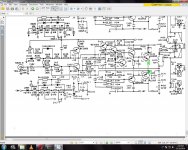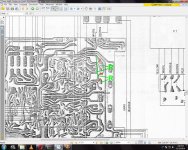Hi folks, so I've recently repaired a NAD 7225PE that had one channel blown and one working. I replaced the drivers (B649A, D669A), bias transistor (BD139) and outputs (2N3055, MJ2955) and a few resistors with the same number transistors found on eBay. I did the center voltage and idle current adjustments and both channels adjusted perfectly. However, when I crank the unit up past half way, it blows the new outputs. I've read that the current replacement outputs are different than the originals (epitaxial vs. hometaxial ) and that installing emitter resistors and a resistor between the base of the outputs might help prevent it from blowing.
My question is: A.) does this seem logical? and B.) can someone give a picture or exact description of how to install the emitter resistors? There is a trace from the + of C427 that goes to both emitters of the outputs and this trace continues on the E401. If someone could explain where to cut the traces and where to install the resistors that would be great!
Thanks,
Greg
My question is: A.) does this seem logical? and B.) can someone give a picture or exact description of how to install the emitter resistors? There is a trace from the + of C427 that goes to both emitters of the outputs and this trace continues on the E401. If someone could explain where to cut the traces and where to install the resistors that would be great!
Thanks,
Greg
Transistors and Ebay can often equal FAKE. It is a real possibility.
Not personally familiar with the mod you mention although I seem to recall hearing of it in the past. That said, emitter resistors are pretty much mandatory for bjt outputs to ensure stability. I would have to see the circuit but typically a 0.22 ohm would be around the correct value. B-E resistors could typically be in the 100 to 220 ohm region. Again, I would have to see the circuit.
Not personally familiar with the mod you mention although I seem to recall hearing of it in the past. That said, emitter resistors are pretty much mandatory for bjt outputs to ensure stability. I would have to see the circuit but typically a 0.22 ohm would be around the correct value. B-E resistors could typically be in the 100 to 220 ohm region. Again, I would have to see the circuit.
There you go (below 1/2).
Mooly is right , I would not trust ANY ebay semi.
Mouser/Digikey is a better bet.
This nad is Bootstrapped ,as well.
I would replace it with maybe a MJ15003/4 (2mhz fT) ,
or genuine 3055/2955 (which is 2.5mhz fT).
This nad is compensated for these "slow" outputs. A fast newer OP would
most likely oscillate.
OS
Mooly is right , I would not trust ANY ebay semi.
Mouser/Digikey is a better bet.
This nad is Bootstrapped ,as well.
I would replace it with maybe a MJ15003/4 (2mhz fT) ,
or genuine 3055/2955 (which is 2.5mhz fT).
This nad is compensated for these "slow" outputs. A fast newer OP would
most likely oscillate.
OS
Attachments
Thank you both for the replies... I was wondering about the quality of those eBay outputs, but hadn't found originals. I'll order some of the MJ15003/4's and do the emitter mods. I'm thinking about leaving the working channel alone as it's still working good after all these years, unless you think it's a bad idea. My customer is hoping to get this back by thanksgiving, so I'm hoping for no more setbacks.
Thank you both for the replies... I was wondering about the quality of those eBay outputs, but hadn't found originals. I'll order some of the MJ15003/4's and do the emitter mods. I'm thinking about leaving the working channel alone as it's still working good after all these years, unless you think it's a bad idea. My customer is hoping to get this back by thanksgiving, so I'm hoping for no more setbacks.
Definitely don't fix what is not broken. This is an old timer, but they were good value back in the day.
I'm doing some long distance guess work, but you need to know why this failed to begin with. It could be an old cap dried out, or other part failed. It will just blow again with new parts unless you find root cause. The service manual is here:
NAD 7020I 7225PE SM 2 Service Manual free download, schematics, eeprom, repair info for electronics
I'm suspecting the Vbe multiplier is bad, so you get high bias and runaway. I always check these when doing repairs, because I don't like doing it twice.
There is a signal diode in the Vbe circuit, and I sometimes get those dead. Check all components in the Vbe. Then I'd check all the active components. You could have a dried out cap too, so watch them. Good luck.
I bought off ebay a 1980 Maplin 225WRMS amp with missing 2n3055 and MJ2955's.
I got new transistors from RS Components.
On power up the amplifier oscillated badly.
Turned out the new transistors had much more gain than the originals.
I had to dampen the amp VAS with a larger capacitor to stop the oscillation.
I designed a similar amp for myself and found I needed 10R's between driver transistors and bases of 2n3055 and MJ2955.
I got new transistors from RS Components.
On power up the amplifier oscillated badly.
Turned out the new transistors had much more gain than the originals.
I had to dampen the amp VAS with a larger capacitor to stop the oscillation.
I designed a similar amp for myself and found I needed 10R's between driver transistors and bases of 2n3055 and MJ2955.
Thank you all for the replies. I did replace all the caps in that channel's circuit and the BD139 bias transistor. I checked all resistors and other transistors and diodes as well before firing it up the first time. Just to reiterate, this thing will run cool as a cucumber all day long at low volumes, but the moment it goes past about 50% on the dial it blows the outputs on the repaired channel. So, I'm thinking the problem has to do with cheap / incorrect transistors from eBay.
So, let me confirm what you're all suggesting:
1. Replacing eBay outputs with MJ15003/4's. and might as well do the bias transistor as well. What about just ordering these 2N3055 and MJ2955 and BD139 from Digikey?
MJ2955G ON Semiconductor | Discrete Semiconductor Products | DigiKey
2N3055G ON Semiconductor | Discrete Semiconductor Products | DigiKey
BD139G ON Semiconductor | Discrete Semiconductor Products | DigiKey
2. Then install .22 or .33ohm 3w emitter resistors and cut traces to isolate the circuit.
3. Install 4.7 ohm resistors (1 watt?) between trace and Base of outputs
4. Check the rest of the circuit for leaky caps, diodes, etc.
I'm hoping this will do it, but am also wondering why ordering the original part numbers from Digikey isn't best.
Thanks again,
Greg
So, let me confirm what you're all suggesting:
1. Replacing eBay outputs with MJ15003/4's. and might as well do the bias transistor as well. What about just ordering these 2N3055 and MJ2955 and BD139 from Digikey?
MJ2955G ON Semiconductor | Discrete Semiconductor Products | DigiKey
2N3055G ON Semiconductor | Discrete Semiconductor Products | DigiKey
BD139G ON Semiconductor | Discrete Semiconductor Products | DigiKey
2. Then install .22 or .33ohm 3w emitter resistors and cut traces to isolate the circuit.
3. Install 4.7 ohm resistors (1 watt?) between trace and Base of outputs
4. Check the rest of the circuit for leaky caps, diodes, etc.
I'm hoping this will do it, but am also wondering why ordering the original part numbers from Digikey isn't best.
Thanks again,
Greg
Last edited:
Definitely dont run amp without emitter resistors (0.22R)
I would start by running the amp without output transistors.
Check bias with an input signal that it doesnt go out of bounds.
You might have to dc couple it to see if bias goes wrong at higher level of DC.
Then put a mains lamp in series with the amp to limit current.
Run power amp with output transistors in and monitor output with/without signal for oscillation.
I would start by running the amp without output transistors.
Check bias with an input signal that it doesnt go out of bounds.
You might have to dc couple it to see if bias goes wrong at higher level of DC.
Then put a mains lamp in series with the amp to limit current.
Run power amp with output transistors in and monitor output with/without signal for oscillation.
Just to reiterate, this thing will run cool as a cucumber all day long at low volumes, but the moment it goes past about 50% on the dial it blows the outputs on the repaired channel
Is this one of the 'Power Envelope' series of amps from NAD that boosts PSU rails during peak programme levels ? I guess so from the PE in the name.....
Then that probably is a big clue: there might be a fault that only applies when this boost is applied. Perhaps one side of the boost supply ( + or -) is missing or jams on, resulting in asymmetry and messed up bias ? There's a similar thread currently about 7240PE amp here a few threads down........
I would look at that section of the circuit. I wouldn't power this circuit with a bulb in the mains circuit FWIW - it's tough enough to work out how it's supposed to work when rails are at correct potentials as they should be........
LD
UPDATE it's FIXED!
Hi everyone, I wanted to thank you all for your input. I've got it fixed by installing .33, 3 watt resistors in line with the emitters of the outputs and 4.7 ohm, 1 watt resistors in line with the base of the outputs of the blown channel. I also swapped out the driver and output transistors in case the ones I got off eBay were cheap generics. I was able to adjust to 0mV on the speaker outputs and the idler current is stable at 28mA. Cranked it up loud and no smoke! Hooray!
Thanks again,
Greg
Hi everyone, I wanted to thank you all for your input. I've got it fixed by installing .33, 3 watt resistors in line with the emitters of the outputs and 4.7 ohm, 1 watt resistors in line with the base of the outputs of the blown channel. I also swapped out the driver and output transistors in case the ones I got off eBay were cheap generics. I was able to adjust to 0mV on the speaker outputs and the idler current is stable at 28mA. Cranked it up loud and no smoke! Hooray!
Thanks again,
Greg
- Status
- This old topic is closed. If you want to reopen this topic, contact a moderator using the "Report Post" button.
- Home
- Amplifiers
- Solid State
- NAD 7225PE - Blows outputs after repair, question about installing emitter resistors


